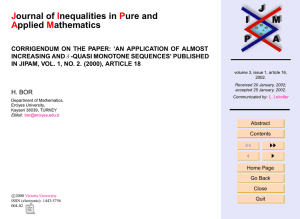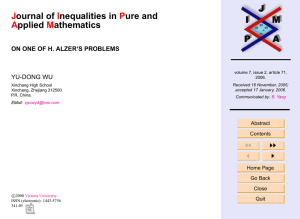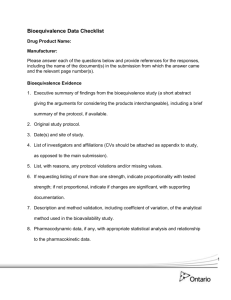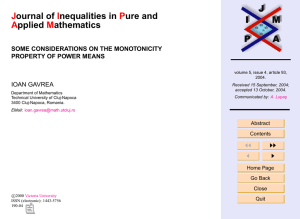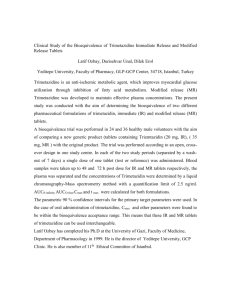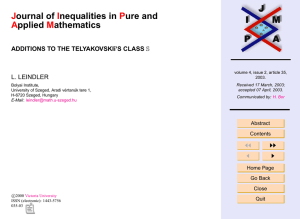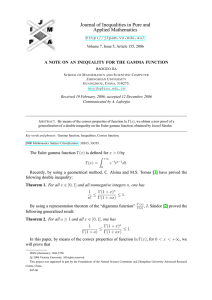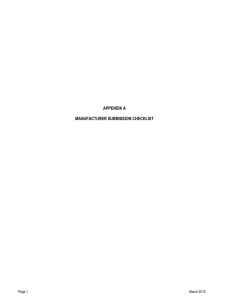J I P A
advertisement
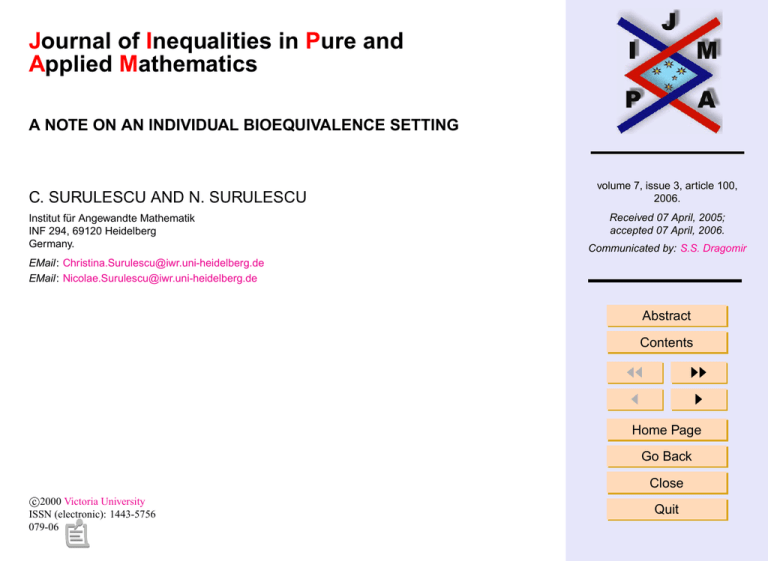
Journal of Inequalities in Pure and
Applied Mathematics
A NOTE ON AN INDIVIDUAL BIOEQUIVALENCE SETTING
C. SURULESCU AND N. SURULESCU
Institut für Angewandte Mathematik
INF 294, 69120 Heidelberg
Germany.
volume 7, issue 3, article 100,
2006.
Received 07 April, 2005;
accepted 07 April, 2006.
Communicated by: S.S. Dragomir
EMail: Christina.Surulescu@iwr.uni-heidelberg.de
EMail: Nicolae.Surulescu@iwr.uni-heidelberg.de
Abstract
Contents
JJ
J
II
I
Home Page
Go Back
Close
c
2000
Victoria University
ISSN (electronic): 1443-5756
079-06
Quit
Abstract
We give a new simpler proof along with a generalization for the inequality of Yao
and Iyer [10] arising in bioequivalence studies and by using a nonparametric
approach we also discuss an extension of the individual bioequivalence setting
to the case where the data are not necessarily normally distributed.
2000 Mathematics Subject Classification: 60E15, 62F03, 62P10.
Key words: Bioequivalence, Probabilistic inequalities
Contents
1
Introduction . . . . . . . . . . . . . . . . . . . . . . . . . . . . . . . . . . . . . . . . . 3
2
A Generalization of the Inequality of Yao and Iyer . . . . . . . . . 6
3
A Nonparametric Approach for the Bioequivalence Setting . . 10
4
Conclusions . . . . . . . . . . . . . . . . . . . . . . . . . . . . . . . . . . . . . . . . . 15
A
Proofs . . . . . . . . . . . . . . . . . . . . . . . . . . . . . . . . . . . . . . . . . . . . . . 16
References
A Note on an Individual
Bioequivalence Setting
C. Surulescu and N. Surulescu
Title Page
Contents
JJ
J
II
I
Go Back
Close
Quit
Page 2 of 21
J. Ineq. Pure and Appl. Math. 7(3) Art. 100, 2006
http://jipam.vu.edu.au
1.
Introduction
Bioequivalence testing is required when trying to get the approval for manufacturing and selling of a generic drug having mainly the same properties with
a (more expensive) reference (brand-name) drug. Establishing bioequivalence
saves the generic drug manufacturer from performing expensive clinical trials
to demonstrate the quality of his product. Two drugs are considered bioequivalent if they are absorbed into the blood and become active at about the same
rate and concentration. Bioequivalent drugs are supposed to provide the same
therapeutic effect.
For explaining the notions and notations we use, we recall the problem setting in [10] for the individual bioequivalence. Thus, the amount of the chemical
absorbed by a patient’s bloodstream when using a reference drug is a random
variable X, which has mean µR and standard deviation σR . The corresponding variable for the same patient when using the generic drug has mean µT and
standard deviation σT . The therapeutic window of a patient is defined to be the
interval in which must lie the concentration of the chemical in the bloodstream,
in order for the drug to be classified as beneficial for that patient. Usually,
the therapeutic window is assumed to be an interval centered at the mean µR ,
namely the range (µR − zσR , µR + zσR ). The drug will be uneffective if the
amount absorbed in the bloodstream is too low and it could cause severe side
effects if too much of the chemical substance is absorbed.
Denoting by pR and pT the probabilities that the subject will have benefit
from using drug R, respectively T , the regulatory agency might approve the
marketing of drug T provided that ppRT ≥ γ, where γ is about 1 or even larger.
The therapeutic window of a patient is generally unknown, therefore a quan-
A Note on an Individual
Bioequivalence Setting
C. Surulescu and N. Surulescu
Title Page
Contents
JJ
J
II
I
Go Back
Close
Quit
Page 3 of 21
J. Ineq. Pure and Appl. Math. 7(3) Art. 100, 2006
http://jipam.vu.edu.au
tity of interest for the approval procedure will be inf z≥0 ppRT .
Usually, to derive this quantity the assumption that X and T have normal
distributions is made, though it is well known that in practice this is rarely the
case. Under this assumption, Yao and Iyer [10] have shown that
(1.1)
Φ(
pT
= inf
inf
z>0
z>0 pR
(
µR +zσR −µT
σT
R −µT
) − Φ( µR −zσ
)
σT
Φ(z) − Φ(−z)
√
)
µT − µR
σR 2π
= min 1,
φ
,
σT
σT
where φ and Φ are respectively the probability density function and the cumulative density function of a standard normal variable.
Thus, the approval of manufacturing the generic drug T may be granted if
from the statistical analysis of experimental data it can be proven that
√
µT − µR
σR 2π
(1.2)
φ
≥ γ.
σT
σT
A Note on an Individual
Bioequivalence Setting
C. Surulescu and N. Surulescu
Title Page
Contents
JJ
J
II
I
Alternatively to (1.2), a more flexible approval criterion can be used, namely
one of the type
Go Back
`(Zγ ) ≥ bγ ,
Quit
(1.3)
for some large enough given bound bγ , where Zγ := {z > 0 : ppRT > γ} and
` is for instance the Lebesgue measure. We will discuss in the next sections
sufficient conditions for (1.3) to be satisfied.
Close
Page 4 of 21
J. Ineq. Pure and Appl. Math. 7(3) Art. 100, 2006
http://jipam.vu.edu.au
For more information about individual bioequivalence see [1], [7], [8], [4],
[5], [6] and the references therein.
In this paper we give a simpler proof and a generalization of the inequality of Yao and Iyer and we also give a nonparametric extension of the above
bioequivalence setting.
For the sake of clarity, we put all our proofs in the Appendix.
A Note on an Individual
Bioequivalence Setting
C. Surulescu and N. Surulescu
Title Page
Contents
JJ
J
II
I
Go Back
Close
Quit
Page 5 of 21
J. Ineq. Pure and Appl. Math. 7(3) Art. 100, 2006
http://jipam.vu.edu.au
2.
A Generalization of the Inequality of Yao and
Iyer
The main result of Yao and Iyer in [10] was the proof of the following inequality:
( √
)
−z−µ
µ
)
−
Φ(
)
Φ( z−µ
2π
σ
σ
> min 1,
φ
,
(2.1)
Φ(z) − Φ(−z)
σ
σ
for all z > 0, µ ∈ R\{0} and σ ∈ (0, ∞)\{1}; this inequality comes from (1.1)
after some changes of notations.
As in [10], observe that it is enough to treat the case µ ≥ 0. Here we will
prove the following generalization:
Proposition 2.1. In the above settings, we have:
(i) If σ > 1, then
z
−z
µ2 Φ( ) − Φ(
Φ( z−µ
) − Φ( −z−µ
)
)
σ
σ
σ
> e− 2σ2 σ
Φ(z) − Φ(−z)
Φ(z) − Φ(−z)
2
z2
1
1
− µ2 1
2
−
> e 2σ
1+
1− 2 ·z e 2
σ
6
σ
( √
)
1 − µ22
2π µ > e 2σ = min 1,
φ
, ∀z > 0.
σ
σ
σ
A Note on an Individual
Bioequivalence Setting
C. Surulescu and N. Surulescu
Title Page
Contents
JJ
J
II
I
Go Back
Close
Quit
Page 6 of 21
J. Ineq. Pure and Appl. Math. 7(3) Art. 100, 2006
http://jipam.vu.edu.au
(ii) If σ ∈ (0, 1) then
( √
)
−z−µ
µ Φ( z−µ(σ) ) − Φ( −z−µ(σ) )
Φ( z−µ
)
−
Φ(
)
2π
σ
σ
σ
σ
≥ min 1,
φ
Φ(z) − Φ(−z)
σ
σ
Φ(z) − Φ(−z)
( √
)
2π µ (2.2)
> min 1,
φ
, ∀z > 0, ∀µ > 0,
σ
σ
where µ(σ) := σ
q
2 ln σ1 .
A Note on an Individual
Bioequivalence Setting
This result is based on Lemma 2.2, generalising Lemma 3 in [10], (which
was the most difficult part of the proof therein) and on Lemmas 2.3 and 2.4
below.
Lemma 2.2. The function σ 7→ F (σ) :=
decreasing on (0, 1), with µ(σ) as above.
Φ( z−µ(σ)
)
σ
−
Φ( −z−µ(σ)
)
σ
is strictly
Lemma 2.3. For every σ > 0, σ 6= 1, we have:
2 !
Φ σz − Φ −z
z2
1
1
1
σ
(2.3)
− min 1,
>
1 − min 1,
· z 2 e− 2
Φ(z) − Φ(−z)
σ
6σ
σ
z2
1
1
+
− min 1,
e− 2σ2 > 0, ∀z > 0.
σ
σ
C. Surulescu and N. Surulescu
Title Page
Contents
JJ
J
II
I
Go Back
Close
Quit
Page 7 of 21
The following lemma generalises Lemma 1 and Lemma 4 in [10]:
J. Ineq. Pure and Appl. Math. 7(3) Art. 100, 2006
http://jipam.vu.edu.au
Lemma 2.4.
(2.4)
o
n
1
Φ(z − µ1 ) − Φ(−z − µ1 )
2
2
> min 1, e− 2 [(µ1 ) −(µ2 ) ]
Φ(z − µ2 ) − Φ(−z − µ2 )
∀z > 0, µ1 , µ2 ∈ R, µ1 6= µ2 .
Remark 1. Replacing z with σz , µ1 by
µ1
σ
and µ2 by
µ2
σ
then
• for µ1 > µ2 > 0 one has
h
i
h
i
−z−µ1
1
2
2
2
2
µ
µ
µ
µ
Φ z−µ
−
Φ
− 12 ( σ1 ) −( σ2 )
− 12 ( σ1 ) −( σ2 )
σ σ
> min 1, e
=e
,
2
2
Φ z−µ
− Φ −z−µ
σ
σ
A Note on an Individual
Bioequivalence Setting
C. Surulescu and N. Surulescu
thus the function
(0, ∞) 3 µ 7→ B1 (µ) := e
1 µ 2
( )
2 σ
−z − µ
z−µ
Φ
−Φ
σ
σ
Contents
JJ
J
is increasing, i.e. Lemma 1 in [10] is obtained;
• for µ2 > µ1 > 0 one has
1
1
Φ( z−µ
) − Φ( −z−µ
)
σ
σ
> 1,
2
2
Φ( z−µ
) − Φ( −z−µ
)
σ
σ
II
I
Go Back
Close
Quit
thus the function
(0, ∞) 3 µ 7→ B2 (µ) := Φ
Title Page
z−µ
σ
−Φ
−z − µ
σ
Page 8 of 21
J. Ineq. Pure and Appl. Math. 7(3) Art. 100, 2006
is proved to be decreasing, i.e. we obtained Lemma 4 in [10].
http://jipam.vu.edu.au
Remark 2. Sufficient conditions for (1.3) to be satisfied can be easily derived
2
2 − z2
upon using
for
σ
>
1
the
monotonicity
of
the
function
z
→
7
z
e
(increasing
√
√
on (0, 2), decreasing on [ 2, ∞)) and for 0 < σ < 1 the fact that
( √
) z−µ(σ) −z−µ(σ)
−z−µ
z−µ
Φ
−
Φ
Φ σ −Φ σ
σ
σ
2π
µ
> min 1,
φ
Φ(z) − Φ(−z)
σ
σ
Φ(z) − Φ(−z)
)
( √
)
2π µ Φ( σz ) − Φ( −z
σ
≥ σ min 1,
φ
, ∀z > 0
σ
σ
Φ(z) − Φ(−z)
and this term can be minorated by applying Lemma 2.3.
A Note on an Individual
Bioequivalence Setting
C. Surulescu and N. Surulescu
Title Page
Contents
JJ
J
II
I
Go Back
Close
Quit
Page 9 of 21
J. Ineq. Pure and Appl. Math. 7(3) Art. 100, 2006
http://jipam.vu.edu.au
3.
A Nonparametric Approach for the
Bioequivalence Setting
Consider now that the random variables X, T from the Introduction have continuous univariate distributions, with the densities fX , respectively fT , which
are not necessarily Gaussian, and assume that we correspondingly have the independent observations: x1 , . . . , xm , respectively t1 , . . . , tn . Then fX and fT
can be estimated by using the classical nonparametric estimators:
m
X
1
x − xi
ˆ
fX (x) =
·
K
mhX
hX
m
m
i=1
and
n
1 X
fˆT (t) =
·
K
nhTn i=1
t − ti
hTn
,
T
where K is a kernel, hX
m and hn are the bandwidths (with the usual properties:
X
T
T
hm → 0, hn → 0 for m, n → ∞; mhX
m → 0, nhn → ∞ for m, n → ∞ and,
T
of course, hX
m and hn have to be chosen in practice by a corresponding criterion,
see [9]).
With the above notations, the fractions of interest for bioequivalence studies
are
µR +zσ
R R
(3.1)
pT
= R(z) :=
pR
A Note on an Individual
Bioequivalence Setting
C. Surulescu and N. Surulescu
Title Page
Contents
JJ
J
II
I
Go Back
Close
Quit
fT (t)dt
Page 10 of 21
µR −zσR
µR +zσ
R R
µR −zσR
fX (x)dx
J. Ineq. Pure and Appl. Math. 7(3) Art. 100, 2006
http://jipam.vu.edu.au
µR +zσ
R R
≈ R̂(z) :=
fˆT (t)dt
µR −zσR
µR +zσ
R R
,
z > 0,
fˆX (x)dx
µR −zσR
and for the approval procedure it will be important to find the quantity of interest inf z>0 R̂(z), but this is clearly more difficult than for the case presented
in the previous section and an analytic treatment is hardly possible. Even when
considering the Gaussian kernel, the available nonlinear optimization procedures are surprisingly very time consuming. However, a great (and also easy
to implement) simplification can be achieved when using one of the following
kernels (see e.g., [9]):
• the rectangular kernel: K(u) := 12 χ(−1,1) (u);
• the triangular kernel: K(u) := (1 − |u|)χ(−1,1) (u);
• the Epanechnikov kernel: K(u) :=
3
(1
4
2
− u )χ(−1,1) (u);
• the triangle kernel: K(u) := (1 − |u|)χ(−1,1) (u);
• the double Epanechnikov kernel: K(u) := 3|u|(1 − |u|)χ(−1,1) (u).
Moreover, the procedure can also be used for finding the largest therapeutic window under which the fraction of interest exceeds some given positive
constant γ. Since all kernels above are supported on (−1, 1), then the global
minimum can be found in the following way:
A Note on an Individual
Bioequivalence Setting
C. Surulescu and N. Surulescu
Title Page
Contents
JJ
J
II
I
Go Back
Close
Quit
Page 11 of 21
J. Ineq. Pure and Appl. Math. 7(3) Art. 100, 2006
http://jipam.vu.edu.au
• construct AT,+
:= ATn ∩ (0, ∞), where
n
ATn
n [
ti − hTn − µR ti + hTn − µR
:=
−
,
,
σR
σR
i=1
ti − hTn − µR
ti + hTn − µR
, −
σR
σR
;
• construct AX,+
:= AX
m
m ∩ (0, ∞), where
AX
m
A Note on an Individual
Bioequivalence Setting
m X
[
xj − hX
m − µR xj + hm − µR
:=
−
,
,
σ
σ
R
R
j=1
xj + hX
xj − hX
m − µR
m − µR
, −
σR
σR
C. Surulescu and N. Surulescu
Title Page
;
• if K is not the rectangular kernel, then construct A+
T,deriv as the set constituted by the critical points of R̂(z) on the union of the subintervals of
R+ where R̂ is differentiable (which in this case are roots of some polynomials, thus easy to be handled by the computer); if K is the rectangular
kernel, set A+
T,deriv = ∅.
S X,+ S +
• denote A := AT,+
Am
AT,deriv .
n
Contents
JJ
J
II
I
Go Back
Close
Quit
Page 12 of 21
Then we have:
J. Ineq. Pure and Appl. Math. 7(3) Art. 100, 2006
http://jipam.vu.edu.au
Proposition 3.1. With the notations above and with K being one of the kernels
enumerated before,
1
nhT
n
R̂(z) =
1
mhX
m
n
P
µR +zσ
R R
K
i=1 µR −zσR
m
P
µR +zσ
R R
K
i=1 µR −zσR
t−ti
hT
n
dt
n
o
≥ min R̂(zmax ), lim R̂(z), R̂(A) ,
x−xi
hX
m
z→0
dx
where zmax = max{|ζ| : ζ ∈ A},
n
P
lim R̂(z) =
z→0
K
mhX
m i=1
m
T
nhn P
K
i=1
A Note on an Individual
Bioequivalence Setting
µR −ti
hT
n
µR −xi
hX
m
C. Surulescu and N. Surulescu
for the continuous kernels above,
Contents
and
n
P
h
mhX
m i=1
lim R̂(z) =
m h
z→0
nhTn P
i=1
Title Page
K+
K+
µR −ti
hT
n
µR −xi
hX
m
+ K−
i
µR −ti
hT
n
+ K−
µR −xi
hX
m
i for the rectangular kernel,
with the notations K+ (ξ) := limt&ξ K(t), respectively K− (ξ) := limt%ξ K(t).
Remark 3. If K is one of the kernels presented above, then for each γ > 0 and
using an algorithm similar to the one described above one can easily determine
Zγ , in order to check the approval condition (1.3).
JJ
J
II
I
Go Back
Close
Quit
Page 13 of 21
J. Ineq. Pure and Appl. Math. 7(3) Art. 100, 2006
http://jipam.vu.edu.au
Simulation result: Figure 1 illustrates a simulation with m = 150, n = 160
for the case where X and T are normally distributed and the nonparametric
estimators are constructed with the Epanechnikov kernel. The continuous lines
represent R̂(z) and its minimum, which is 0.012; the lines of circles represent
R(z) and its minimum, which is 0.0088. This shows that the Gaussian case can
be well recovered with this nonparametric procedure.
1
A Note on an Individual
Bioequivalence Setting
0.8
C. Surulescu and N. Surulescu
0.6
Title Page
Contents
0.4
JJ
J
0.2
II
I
Go Back
0
4
8
12
16
20
z
Close
Quit
Figure 1: The continuous line is R̂(z); the line of circles is R(z); the horizontal
lines are the corresponding minimums
Page 14 of 21
J. Ineq. Pure and Appl. Math. 7(3) Art. 100, 2006
http://jipam.vu.edu.au
4.
Conclusions
In this paper we gave a generalization and a simpler proof of the inequality
of Yao and Iyer [10] concerning an individual bioequivalence setting when the
data were supposed to be normally distributed. Our generalization can be used
to develop a more flexible approval criterion (of the type (1.3)) for manufacturing and selling a drug which is supposed to be bioequivalent with a reference
one. Finally, we extended these settings to the more general situation when
the data are not necessarily normally distributed, upon using the nonparametric estimation technique. This idea can also be useful in the context of global
nonlinear optimization problems.
A Note on an Individual
Bioequivalence Setting
C. Surulescu and N. Surulescu
Title Page
Contents
JJ
J
II
I
Go Back
Close
Quit
Page 15 of 21
J. Ineq. Pure and Appl. Math. 7(3) Art. 100, 2006
http://jipam.vu.edu.au
A.
Proofs
Proof of Lemma 2.2. Denoting θ := σ1 ∈ (1, ∞), we have
√
√
z − µ(σ)
−z − µ(σ)
Φ
−Φ
= Φ(zθ − 2 ln θ) − Φ(−zθ − 2 ln θ).
σ
σ
√
√
Consider g : (1, ∞) → R, g(θ) := Φ(zθ − 2 ln θ) − Φ(−zθ − 2 ln θ), ∀θ >
1. Observe that
#
" √
√
√
1
zθ 2 ln θ − 1
0
√
+ exp(−2zθ 2 ln θ)
g (θ) = z + √
· φ(zθ − 2 ln θ)
zθ 2 ln θ + 1
θ 2 ln θ
> 0,
√
for all θ > 1, because u := zθ 2 ln θ > 0 and it is easy to see that
u−1
+ e−2u > 0, ∀u > 0.
u+1
A Note on an Individual
Bioequivalence Setting
C. Surulescu and N. Surulescu
Title Page
Contents
JJ
J
II
I
Go Back
Proof of Lemma 2.3. If σ > 1, we can write
Z z
z x2
−z
1
−Φ
= √
e− 2σ2 dx
Φ
σ
σ
σ 2π −z
Z z
2
1
1
1
1
2 − x2
>
Φ(z) − Φ(−z) + √ ·
1− 2
x e dx ,
σ
σ
2π 2
−z
Close
Quit
Page 16 of 21
J. Ineq. Pure and Appl. Math. 7(3) Art. 100, 2006
http://jipam.vu.edu.au
x2
1
since e 2 (1− σ2 ) ≥ 1 +
x2
2
2
− x2
1−
1
σ2
, ∀x ∈ R\{0}. Further, from the decreasing
monotonicity of x 7→ e
on [0, z] deduce that
3
z −z
1
1
1
z − z2
Φ
−Φ
1− 2 · e 2
≥
Φ(z) − Φ(−z) + √
σ
σ
σ
σ
3
2π
and, since
p
Φ(z) − Φ(−z) < z 2/π, ∀z > 0
(2.3) is proved.
For the case where σ ∈ (0, 1) we have:
A Note on an Individual
Bioequivalence Setting
Φ( σz ) − Φ( −z
)
Φ( σz ) − Φ(z)
σ
=1+2
Φ(z) − Φ(−z)
Φ(z) − Φ(−z)
R z 1 − x2
σ √
e 2 dx
z
2π
=1+2
Φ(z) − Φ(−z)
2
− z2
2σ
√1 e
2π
·z
1
σ
C. Surulescu and N. Surulescu
Title Page
Contents
JJ
J
−1
>1+2
Φ(z) − Φ(−z)
z2
1
− 1 e− 2σ2 , ∀z > 0,
>1+
σ
II
I
Go Back
Close
upon using the same method as in the previous case.
Quit
Proof of Lemma 2.4. Let
Page 17 of 21
Q(z) := Φ(z − µ1 ) − Φ(−z − µ1 )
1
− e− 2 [(µ1 )
2 −(µ
2)
2]
[Φ(z − µ2 ) − Φ(−z − µ2 )],
z > 0.
J. Ineq. Pure and Appl. Math. 7(3) Art. 100, 2006
http://jipam.vu.edu.au
Then
2 − 1 [(µ1 )2 +z2 ] ezµ1 + e−zµ1
ezµ2 + e−zµ2
Q (z) = √ e 2
−
2
2
2π
2 − 1 [(µ1 )2 +z2 ]
[cosh(z|µ1 |) − cosh(z|µ2 |)], ∀z > 0.
=√ e 2
2π
0
Now using the fact that the hyperbolic cosine is an increasing function on
(0, ∞), we have that Q0 (z) > 0 if |µ1 | > |µ2 | and Q0 (z) < 0 if |µ1 | < |µ2 |.
Thus, if |µ1 | > |µ2 |, then Q(z) > 0, ∀z > 0, i.e. inequality (2.4) is satisfied,
1
2
2
since the minimum therein is e− 2 [(µ1 ) −(µ2 ) ] .
If |µ1 | < |µ2 |, then consider the function
G(µ) := Φ(z − µ) − Φ(−z − µ)
and observe that it is decreasing on (0, ∞), since its derivative is
1
2
2
G0 (µ) = − √ e−(z +µ )/2 [ezµ − e−zµ ] < 0,
2π
∀z > 0, µ > 0.
A Note on an Individual
Bioequivalence Setting
C. Surulescu and N. Surulescu
Title Page
Contents
JJ
J
II
I
Go Back
Observing that G(µ) = G(−µ), ∀µ ∈ R, we have that G(µ2 ) = G(|µ2 |) <
G(|µ1 |) = G(µ1 ), which proves the inequality in this case.
Proof of Proposition 2.1. In the case (i) observe that we can write
Close
Quit
Page 18 of 21
Φ( z−µ
) − Φ( −z−µ
)
Φ( z−µ
) − Φ( −z−µ
) Φ( σz ) − Φ( −z
)
σ
σ
σ
σ
σ
=
.
·
z
−z
Φ(z) − Φ(−z)
Φ(z) − Φ(−z)
Φ( σ ) − Φ( σ )
J. Ineq. Pure and Appl. Math. 7(3) Art. 100, 2006
http://jipam.vu.edu.au
Now apply Lemma 2.4 for the first term in the right hand side and Lemma 2.3
for the other one.
In the case (ii), if µ ∈ (0, µ(σ)), then we have that B2 (µ) ≥ B2 (µ(σ)) (see
Lemma 2.4 and Remark 1). Further, use Lemma 2.2 to obtain the last inequality
in (2.2).
If µ > µ(σ), then σB1 (µ) ≥ σB1 (µ(σ)) (see again Lemma 2.4 and Remark
1). Then Lemma 2.2 implies that
σB1 (µ(σ))
F (σ)
=
> 1,
Φ(z) − Φ(−z)
Φ(z) − Φ(−z)
which completes the proof.
Proof of Proposition 3.1. The proof follows observing that for each of the kernels above R̂(z) becomes a rapport
S T,+of polynomials on some finite intervals
X,+
dictated by the points in Am
An . Thus, the problem reduces to characterising the minimum of these fractional expressions on such corresponding
finite intervals, which in this particular case means to find the roots of the polynomials at the numerator of the derivatives. It only remains to observe that
limz→∞ R̂(z) = R̂(zmax ).
A Note on an Individual
Bioequivalence Setting
C. Surulescu and N. Surulescu
Title Page
Contents
JJ
J
II
I
Go Back
Close
Quit
Page 19 of 21
J. Ineq. Pure and Appl. Math. 7(3) Art. 100, 2006
http://jipam.vu.edu.au
References
[1] S. ANDERSON AND W.W. HAUCK, Consideration of individual bioequivalence, J. of Parmacokinetics and Biopharmaceutics, 18 (1990), 259–
274.
[2] I.G. GRAMA, On moderate deviations for martingales, The Annals of
Probability, 25(1) (1997), 152–183.
[3] B. JONES AND M.G. KENWARD, Design and Analysis of Cross-Over
Trials (2nd edition), Chapman & Hall, 2003.
[4] B.F.J. MANLY AND R.I.C.C. FRANCIS, Testing for mean and variance
differences with samples from distributions that may be non-normal with
unequal variances, Journal of Statistical Computation and Simulation,
72(8) (2002), 633–646.
[5] B.F.J. MANLY, One-sided tests of bioequivalence with nonnormal distributions and unequal variances, Journal of Agricultural, Biological and Environmental Statistics, 9(3) (2004), 270–283.
[6] L.L.MCDONALD, S. HOWLIN, J. POLYAKOVA AND C.J. BILBROUGH, Evaluation and Comparison of Hypothesis Testing Techniques
for Bond Release Applications, a project for the Abandoned Coal Mine
Lands Research Program at the University of Wyoming, 2003.
[7] R. SCHALL, Assessment of individual and population bioequivalence using the probability that bioavailabilities are similar, Biometrics, 51 (1995),
615–626.
A Note on an Individual
Bioequivalence Setting
C. Surulescu and N. Surulescu
Title Page
Contents
JJ
J
II
I
Go Back
Close
Quit
Page 20 of 21
J. Ineq. Pure and Appl. Math. 7(3) Art. 100, 2006
http://jipam.vu.edu.au
[8] R. SCHALL AND H.G. LUUS, On population and individual bioequivalence, Statistics in Medicine, 12 (1993), 1109–1124.
[9] D.W. SCOTT, Multivariate Density Estimation. Theory, Practice, and Visualization, John Wiley & Sons, 1992.
[10] YI-CHING YAO AND H. IYER, On an inequality for the normal distribution arising in bioequivalence studies, J. Appl. Prob., 36 (1999), 279–286.
A Note on an Individual
Bioequivalence Setting
C. Surulescu and N. Surulescu
Title Page
Contents
JJ
J
II
I
Go Back
Close
Quit
Page 21 of 21
J. Ineq. Pure and Appl. Math. 7(3) Art. 100, 2006
http://jipam.vu.edu.au

